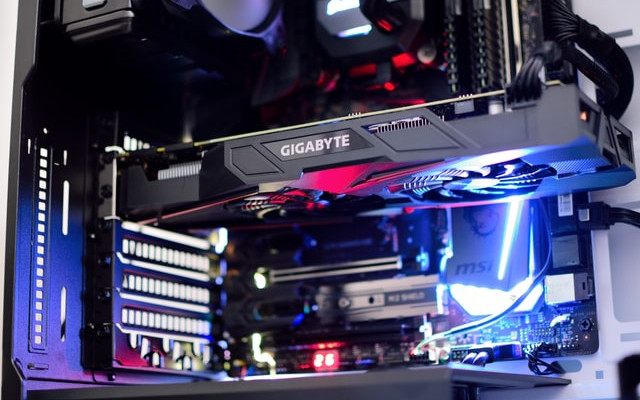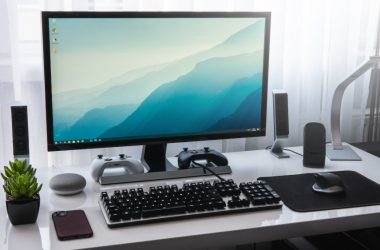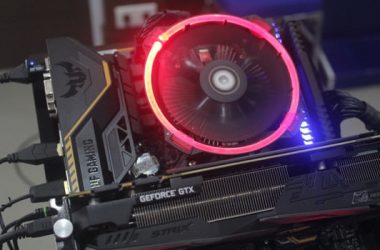For gamers, the graphics card perhaps jostles with the processor to be the most essential component of the PC.
Gamers would know how important it is to choose the best graphics card within their budget and check its compatibility with the other hardware components like processor and motherboard for squeezing out the best performance during heavy graphics workloads.
While you have the freedom of changing graphics cards in desktops later, you can hardly swap them on laptops.
We mostly find 2D and 3D graphics while operating computers. The text and pictures displayed on the operating system are 2D imagery that is managed by onboard graphics accelerators. These onboard graphics processors are enough to get regular work done.
However, the moment you step into 3D imagery such as in games and heavy content creation, the onboard graphics chip just doesn’t cut the cloth. You would need discrete GPUs that are robust and can handle 3D character movement.
Modern GPUs (or graphics cards) also come with a host of specifications, terminologies, and numbers that you ought to know in detail to choose the right card that will get the job done.
This article aims to be an ultimate knowledge base that we hope is going to stand the test of time and be relevant for years to come.
Let’s start with the ever popular question regarding graphics cards. Nvidia or AMD?
Table of Contents
AMD or Nvidia
The Red (AMD) and Green (Nvidia) teams have been in the market for long innovating and implementing relentlessly over the years in a bid to surpass each other.
AMD could slightly look for a bias as they have been fighting on two fronts since acquiring ATI Technologies. They are removing Intel’s processor hegemony and becoming an alternative to Nvidia’s GPU overpricing strategy.
While various manufacturers churn out hundreds of graphics cards each year, only these two companies make the GPUs at the heart of these graphics cards. With the RDNA 2 powered RX 6000 cards, AMD is giving Nvidia, and its current-gen of Ampere cards such as the RTX 3080 and 3090 cards, a serious run for their money.
However, Nvidia has revealed some aces in the form of real-time Ray Tracing technology in its last generation RTX 20 cards.
AMD could only respond to this genius move by team Green in 2020, with its RX 6000 series cards, but Nvidia is already in round two of the Ray Tracing fight with the RTX 30 series.
AMD has to run faster than Nvidia if it wants to catch up because the Greens are on their way to a touchdown.
Thankfully, the number of games that make full use of this revolutionary technology is low, and no matter how fast Nvidia runs, the rest of the industry has been slow to respond, which might just give AMD the time they need to catch up.
Hence, if you are in for the latest tech and like to possess a 5G smartphone, even if there is no or limited 5G network in your country yet, you should go for the latest Nvidia cards.
Right now, there are at most 25 top titles that manage ray-tracing and only half a dozen that actually do justice by whole-heartedly implementing it.
All said and done, ray-tracing is the future, and you won’t be probably changing your graphics card every two years like your smartphone, and hence you would have a nice bit of future-proofing in your hardware with the latest Nvidia cards.
Nvidia’s DLSS, which is an AI-assisted resolution upscaling feature, however, has been replicated by AMD already under the moniker of Fidelity FX Super Resolution or AMD FSR, which is already supported in a lot of upcoming AAA titles. Both DLSS and AMD FSR improve gaming performance on high resolutions, reducing the hit taken on frame rates.
Here again, the Nvidia are into the second round with DLSS 2.0 on the verge of launch, while AMD has to work on perfecting its FSR and bettering it at the same time.
Due to an overall better gaming performance and faster implementation of the latest technology, Nvidia is still the king of graphics cards.
AMD is very good at catching up and implementing what it sees immediately, but we don’t catch up unless we have missed something in the first place. There is still a lot of research and development required for AMD to top Nvidia for good.
Adding to AMD’s woes is the global chip supply shortage owing to the crypto boom, and according to a Steam Hardware Survey (from August 2021) and eBay’s GPU sales figures, Nvidia is selling about ten Ampere cards to AMD’s single RDNA 2 GPU.
AMD’s landing of some solid blows from time to time forces Nvidia to keep innovating in technology, (DLSS and Ray Tracing) performance and features to hold on to its crown. AMD’s promises of making new cards available are more on paper as Nvidia cards are easier to find on eCommerce portals and offline stores even in these trying times of global GPU shortage.
Now let’s look at some of the integral tech specs of graphics that you should know when purchasing a graphics card. We have divided them into two sections.
Critical Technical Specifications
The critical specifications are a must-know for anyone who is planning to buy a graphics card. You may end up with the wrong GPU if you don’t take these specs into account.
1. VRAM (Video RAM) Amount
VRAM is just like regular RAM, only more powerful and specialized at managing graphics. This also implies that VRAM cannot perform any other function other than rendering graphics, and you would still need regular RAM for your machine to function smoothly.
Many consider this to be the single most critical feature of graphics cards. You will need more Video RAM if you plan to game on high resolution and settings because, with an increase in quality, the graphics card would require more memory.
For simplicity, you can consider the GPU to be a micro-computer inside your computer whose purpose is to work on the graphics alone, and the VRAM is its memory. Some part of the VRAM includes a Z-buffer component that stores information regarding the depth of different visual elements in the 3D space.
Modern cards come with a range of VRAM, and they range from 2GB to 24GB.
If you are a hard-core gamer and only into AAA titles at 1080p or 1440p resolution with settings driven up high, then 6GB should be the minimum VRAM on your card. You can manage HD gaming with a lesser capacity card, but you need more than 8GB for 4K gaming.
Content creation may require an even higher amount of graphics memory and creators usually end up with the 24GB variant of Nvidia’s flagship, the RTX 3090.
2. Memory Speed / Bandwidth
The speed of a graphics card depends a lot on the card’s memory. It is measured as GDDR (Graphics Double Data Rate). This is the type of Video RAM in a graphics card and determines the efficiency at which it transfers data.
The current standard is GDDR6X which is around 15-20 percent faster than GDDR5 due to the increased bandwidth of the memory. GDDR6X is more power-efficient and faster than GDDR5, with the former needing less voltage and having double the memory channel of the latter.
Anything earlier than GDDR5 is too dated, and you should stick to a card between GDDR5, GDDR5X, GDDR6, and GDDR6X memory types.
The last two are the latest standards, and graphics cards with these memory types would come at a very high cost.
3. Clock Speed
An essential specification with graphics cards is their clock speed that is measured in megahertz (MHz) and tells you the frequency at which the graphics processing unit inside the graphics card can render graphics.
Higher clock speed would result in a faster rendering of frames and smoother gaming and rendering.
Two cards with the same GPU might have different clock speeds (as tuned by the manufacturer) and hence perform differently with the card with a higher core clock processing more frames than the one with a lower core clock. Clock speed alone does not decide the performance of a graphics card, and other specs like memory speed, architecture, and core counts also have a large say here.
If a GPU with high clock speed runs on an old architecture or has inadequate video memory, its overall performance would be slower than another GPU with a lower clock speed that’s on a better architecture. For example, an RTX 2080 with a very high clock speed won’t outperform an RTX 3080 with a lower clock speed.
Advanced users use various tools to wring out a bit more performance from their graphics cards through overclocking.
Overclocking is a risky procedure that should be attempted only by experts and after proper research as it involves forcing your GPU to run at a higher clock speed than what it came with.
MSI Afterburner is an excellent app that supports overclocking of different graphics cards safely. Some graphics cards come overclocked from the factory and can be identified from their names. It would help if you stayed away from overclocking them.
4. TDP
Thermal Design Power (TDP) is actually a measurement of heat dissipation, but for the everyday user, it is an estimate of how much power you’ll need to run your graphics card without overclocking (overclocking requires increasing the wattage of graphics cards).
Modern graphics cards are power hungry as in addition to the GPU itself, they need additional power to run the fans on the heatsink. Your PSU should be able to supply the required TDP of your graphics card with a bit of headroom for future overclocking.
A rough estimate of the wattage requirements can be obtained from the Outer Vision PS Calculator that considers the power requirements of all of your fundamental components and tells you the wattage your PSU needs. You can manually add up the power numbers too for each of your components but that could be tedious. The PSU should always be an 80+ certified with at least 200 watts more than what your calculations sum up to for some extra headway for future upgrades.
5. Power Connectors
It is no longer the days of the Radeon HD 7750 or GTX 750Ti that needed just 75 watts which the x16 PCIe slot supplied. Modern graphics cards are power-hungry beasts that require additional PCIe power connectors that come in 6 or 8-pin varieties.
Your power supply should have these connectors, or you will need to upgrade your PSU or get adapters that convert Molex power pins into PCIe power connectors. A good example would be the high-end Radeon RX 6900 XT TOXIC from Sapphire that needs 6-pin and dual 8-pin connectors.
It is always best to have PSU directly supplying the power in place of adapters as they tend to melt due to heat or cause loss in efficiency over time.6. Display Ports
VGA is long gone, DVI is on the brink of extinction, and even HDMI 1.4 is somewhat under fire. Modern graphics cards come with HDMI 2.1 and Display Ports, and some also come with Thunderbolt and USB C ports. Your graphics card would send signals over a cable, and the ports on your monitor must match with the ones on your graphics card.
Usually, there are multiple display output ports on your card, as current-generation graphics cards can power multi-monitor setups. There is a single HDMI port at least that makes graphics cards compatible with most monitors, TVs, and projectors.
Older HDMI ports support up to 3840 x 2160 resolution but at a low refresh rate of 60Hz. HDMI 2.1 is a newer iteration that can do 4K at 144Hz and 8K at 30Hz. Next comes the DisplayPort that is slowly gaining popularity amongst gamers and supports 4K with a standard 120Hz refresh rate and 8K at 30Hz.
7. API
An API or Application Programming Interface is an instruction set that directs how the GPU should process the graphics in complex programs such as games. DirectX version 12, OpenGL 4.6, and Vulkan 1.2 are the three APIs that the GPU uses to interact with the applications and process graphical data. DirectX 12 gives better ambient occlusion effects and dynamic lighting features than its predecessor, Dx11.
Your GPU should support the latest prevailing API version. These would enable graphics cards to process the information it is given regarding the programs (games and heavy content applications like Autodesk Maya) you want to run.
Important Technical Specifications
The next few are the specifications are important but not critical and you would do good to know. A graphics card is made up of a combination of various essential specifications. These might not be the primary specifications but they sure have a considerable say in the performance of a graphics card.
1. CUDA Cores / Stream Processors
Like clock speed, CUDA Cores or Stream Processors determine only a part of the graphics card’s capabilities. NVIDIA has a trademark on CUDA, while AMD has on Stream Processors. Usually, the more CUDA Cores or Stream Processors, the faster a GPU, but this is true only when cards with the same architecture and GPU vendor are considered.
For example, comparing Nvidia’s CUDA Cores and AMD’s Stream Processors is useless as they are not valued equally. Architecture is more important for this comparison, and hence more CUDA Cores in an Nvidia Pascal card vs. less in an Ampere card does not mean the Pascal card is better.
2. Memory Clock Speed
Not to be confused with memory and core clock speed.
Memory Clock Speed is the frequency at which the VRAM (Video RAM) works. The principle, however, is similar to the core clock, where a bigger number indicates more power to the graphics card at a faster rate.
However, this too depends on the architecture to be of better use. It also depends on the clock speed of the graphics card and hence becomes relevant only when the GPU comes with a higher clock speed.
3. Shaders
Shaders are components programmed inside a GPU to handle shading and shadowing and are helpful in games that use shading and shadowing. Shaders are divided into three parts. Pixel shaders are the most basic units and essential to generate a base-level color. Next are Vertex shaders that are responsible for running complex algorithms that correlate 3D locations to 2D screen render.
Finally, the Geometry shaders are the most complicated and handle all of those complex shading scenes you see during 3D gameplay. A GPU’s shading capability depends on the number of shaders present in it. The Nvidia GTX 1060 is a highly competent budget card that can run many AAA titles at high settings and comes with 1,280 shaders. Just one step below the ladder is another budget card, the GTX 1050 Ti that has 768 shaders and can handle the same games but at medium-low settings.
4. Architecture
While many don’t look into architecture much, and we agree this is a bit into the geek category, the reason to include it is to complete the loop we created while mentioning the importance of architecture in Clock Speed and Memory Clock.
To keep things simple, the architecture of a graphics card can be considered as the foundation on which a GPU is built. It is the placement of the circuits, die size, and layout of the GPU chip.
Every chip maker ranging from processor makers to GPU makers strive for more efficiency reducing the die size through power-efficient transistors, semiconductors, and other necessary components every few years by.
Think of it like laptop makers reducing the form factor and going for smaller and thinner designs while aiming for battery efficiency and better performance.
Cards with the latest architecture are much faster and offer a better price to performance ratio than cards based on older architecture.
5. Form Factor
Form factor deals with the physical structure of the graphics card.
It is for you to make sure you have enough room in your case for the graphics card. There should be adequate clearance for modern generation cards as even budget cards take up two slots nowadays. This is mainly due to a large heatsink deployed to dissipate the heat produced, and bigger fans that keep the heat sink cool.
Some of the latest AMD RX 6000 series cards come with three slots, and if there is a PCIe add-on card installed just beside your PCIe x16 slot, you are in trouble.Mini-ITX boards are thoroughly non-suitable for the current generation cards, and you should look for eATX boards if you plan to use the different PCIe slots for add-on cards.
6. Physical Interface
In the present generation, it is futile to talk about older generation interfaces like AGP or PCI X, as all motherboards today come with PCI Express slots. These slots are marked as PCIe x1, PCIe x4, PCIe x8, and PCIe x16 and have bandwidths of 1,4,8 and 16GB/s in the older PCIe 3.0 version. The latest PCIe 4.0 slots operate at double the speed of PCIe 3.0.
Graphics cards have historically been used with the fastest slots since they came into existence as their VRAM is faster than regular RAM, and the current generation of PCIe 4.0 allows a massive 32GB/s data transfer bandwidth to the latest graphics cards.
However, this is applicable only if the graphics cards themselves come with a PCIe 4.0 interface.
It is strongly advised to go for PCIe-based GPUs for regular use and aim for slot version compatibility.
With the specifications explained, here are some quick tips for you to keep in mind when you buy your graphics card
GPU Buying Tips
The CPU is Important
You should spend wisely on a GPU and buy a CPU that can stand toe to toe with your GPU. A bottleneck can happen if either of the components is too powerful than the other. Your returns start diminishing in that case. If your GPU is too powerful, benchmarks might not reflect it, and you might face the music during actual gameplay as the minimum frame rates would fall.
Monitor Resolution and Refresh Rate
Planning to game on 4K with your new RTX card? Good, make sure you have a monitor that supports 4K. Mainstream gaming mostly happens over 1080p or 1440p resolution, and most gaming monitors would support it.
High resolution will not be of much help if your monitor does not come with a triple-digit refresh rate. A top-of-the-line graphics card would process frames fast, and your monitor must support fast frame switching through a high refresh rate for pristine gaming. There is absolutely no point in getting a powerful graphics card if your monitor cannot keep up with its frame processing speed.
A Better Case
Graphics cards are now lengthier and broader than they used to be. With advancements in technology, even budget cards like the Radeon RX 570 come in a two-slot design that needs more space. Your PC case should have enough space with clearance for the wires to pass through to accommodate the big sized graphics cards of today.
Power Issues
Only a trivial number of cards can manage with the power they draw from the connecting ports nowadays. Hence, consider the power requirements of your shortlisted card and check if your PSU can handle that power. You also need to check if the PSU comes with the necessary 6-pin or 8-pin power connectors. The final thing to keep in mind here is the efficiency of the PSU. Unless 80+ certified, most PSUs would be delivering just 65-70 percent of the promised wattage.
Avoid SLI or Crossfire
Support for dual-cards has been declining over the years, and multi-GPU setups are extremely troublesome to set up. Current generation cards are very powerful, and unless you are a niche user looking to mine crypto, there is absolutely no point in getting a multi-GPU setup. The best single card you can afford is going to be sufficient.
Overclocking isn’t a Game Changer
It never was, actually. Overclocking the CPU or GPU can give a maximum of 10-15 percent boost in performance enough to make an unplayable title with a meager FPS count, barely playable. Overclocking will not double your FPS count, so avoid getting an underwhelming card for gaming then relying on OCing it to help you cross the river.
Conclusion
Any hardware is a complex piece of technology, and that usually has a lot of jargon and numbers attached with it. Some of these numbers are difficult for the average joe to understand, but they contain valuable information, which might be the difference between partial and complete compatibility between several hardware components.
Compatibility issues hinder components from reaching their full potential, and there is a performance loss of around 10-15 percent on average.
Hence you must try and read as much as possible and research the terms you come across for the first time to get a complete insight into the hardware you are planning to purchase.
Graphics Card Specifications Explained: FAQ
What are some of the best graphics cards right now?
The RTX 30 series cards from Nvidia come with Ray-Tracing and DLSS and never-seen-before Ampere architecture are making headlines right now. These cards draw a lot of power, but their performance is top-notch. AMD’s RX 6000 series cards are equally efficient, but all of these cards are expensive and are probably overkill for mainstream gamers.
Are integrated GPUs any good?
Right now, there are only a few integrated GPU solutions available. Intel’s UHD graphics found in some laptops is simply not meant for mainstream gaming, but the latest Intel Iris Xe is much more powerful with a good core clock speed and more graphics processors. It allows medium gaming at medium-high resolution.
It is not a full-blown graphics solution but does bring in considerable power without discrete graphics.
Are budget cards any good?
As newer products are launched, powerful cards from earlier generations are shifted downwards in the graphics card hierarchy charts to make space for the new leaders.
This, however, does not diminish the capacity of those cards. Presently cards like Radeon RX 5500XT, GTX 1650, and Super and RX 570 fall in the budget segment as they can manage most games at Full HD resolution with medium settings. Once they were considered medium-high end cards. The Radeon RX 570 can even manage entry-level VR.
What has G-Sync or FreeSync anything to do with graphics cards?
Nvidia G-Sync and AMD FreeSync are Adaptive Sync features that reduce screen tearing and choppy images in monitors by making their refresh rate sync up with the frames processing speed of the graphics cards. Application of these technologies results in smoother gameplay.
These proprietary technologies are touted to work best with their respective graphics cards, and plenty of monitors support both. Graphics cards have nothing to do with G-Sync or FreeSync directly. These are purely monitor specific features.





